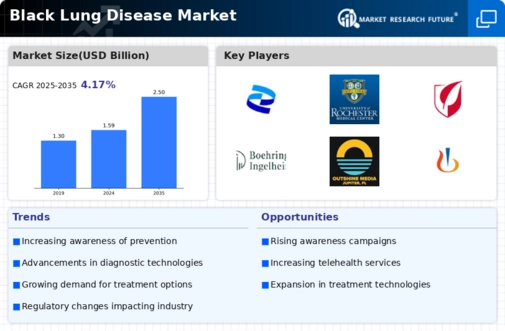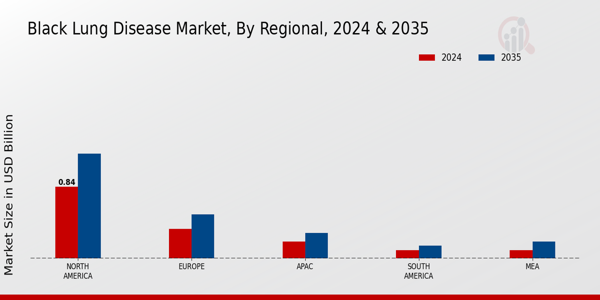Black Lung Disease Size
Black Lung Disease Market Growth Projections and Opportunities
Occupational hazards in coal mining affect the black lung disease therapy market. Long-term coal dust exposure causes black lung disease, or coal workers' pneumoconiosis (CWP), which is common among coal miners. The prevalence of this occupational health concern and the demand for appropriate therapies drive market dynamics. Internationally, black lung disease is on the increase in several places. Regional differences in mining, dust management, and regulatory monitoring affect treatment and healthcare need. The market is affected by black lung disease severity, from coal miners' pneumoconiosis to progressive severe fibrosis. The necessity for varied treatment techniques at different illness stages leads research and development and develops therapeutic alternatives. The major symptoms of black lung disease include coughing, shortness of breath, and lung function impairment. Therapeutics that enhance lung function, respiratory symptoms, and quality of life drive the market. Market considerations include black lung disease diagnosis difficulties. Chest X-rays and pulmonary function tests are widespread but have sensitivity and specificity issues. New diagnostic technologies like high-resolution computed tomography (HRCT) seek to increase accuracy and early diagnosis, affecting treatment tactics. Mining occupational safety measures affect the market. Dust management, respiratory protection, and regulatory requirements to reduce coal dust exposure help prevent black lung disease and define treatment demand. Smoking may worsen black lung disease. Smoking and coal dust exposure affect the market, stressing the necessity of smoking cessation programs in holistic therapy. Black lung disease treatment involves pulmonary rehabilitation. The market is driven by demand for rehabilitation programs that improve lung function, exercise capacity, and respiratory symptoms for holistic patient care. Laws and compensation affect the black lung disease business. Regulations for dust exposure limits, miner health monitoring, and compensation effect preventative measures and treatment and support resources. Black lung disease affects community health beyond afflicted people. In places with high coal mining activity, market considerations affect healthcare infrastructure, community awareness, and disease management resources. Black lung disease may affect patients psychosocially as well as physically. Psychosocial assistance, including mental health treatments, counseling, and community support programs, addresses patients' overall well-being and influences the market. Further research and development will shape the black lung disease therapy market. Treatment choices expand when researchers discover new therapies, understand disease development molecularly, and enhance diagnostic accuracy.
















Leave a Comment